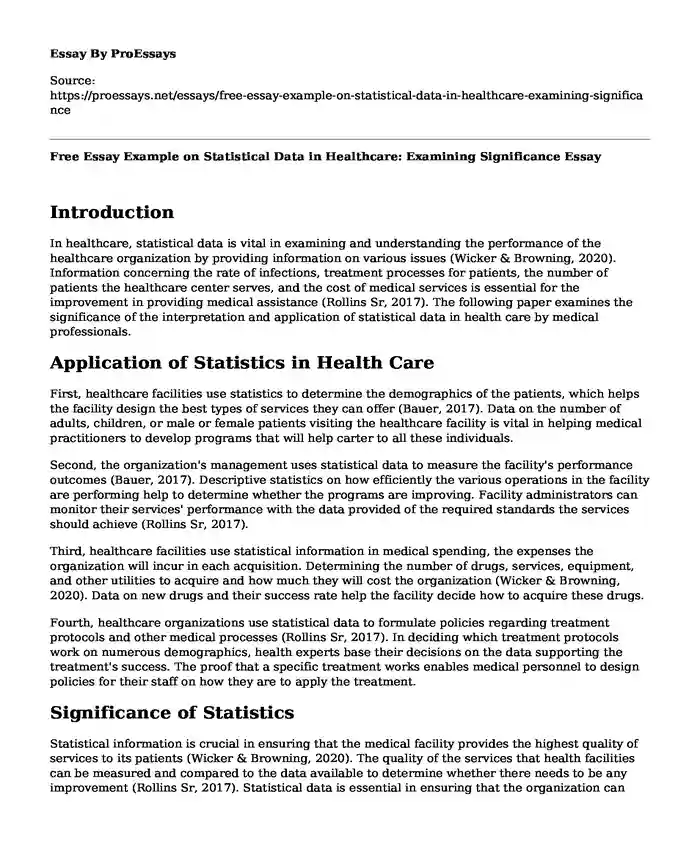Introduction
In healthcare, statistical data is vital in examining and understanding the performance of the healthcare organization by providing information on various issues (Wicker & Browning, 2020). Information concerning the rate of infections, treatment processes for patients, the number of patients the healthcare center serves, and the cost of medical services is essential for the improvement in providing medical assistance (Rollins Sr, 2017). The following paper examines the significance of the interpretation and application of statistical data in health care by medical professionals.
Application of Statistics in Health Care
First, healthcare facilities use statistics to determine the demographics of the patients, which helps the facility design the best types of services they can offer (Bauer, 2017). Data on the number of adults, children, or male or female patients visiting the healthcare facility is vital in helping medical practitioners to develop programs that will help carter to all these individuals.
Second, the organization's management uses statistical data to measure the facility's performance outcomes (Bauer, 2017). Descriptive statistics on how efficiently the various operations in the facility are performing help to determine whether the programs are improving. Facility administrators can monitor their services' performance with the data provided of the required standards the services should achieve (Rollins Sr, 2017).
Third, healthcare facilities use statistical information in medical spending, the expenses the organization will incur in each acquisition. Determining the number of drugs, services, equipment, and other utilities to acquire and how much they will cost the organization (Wicker & Browning, 2020). Data on new drugs and their success rate help the facility decide how to acquire these drugs.
Fourth, healthcare organizations use statistical data to formulate policies regarding treatment protocols and other medical processes (Rollins Sr, 2017). In deciding which treatment protocols work on numerous demographics, health experts base their decisions on the data supporting the treatment's success. The proof that a specific treatment works enables medical personnel to design policies for their staff on how they are to apply the treatment.
Significance of Statistics
Statistical information is crucial in ensuring that the medical facility provides the highest quality of services to its patients (Wicker & Browning, 2020). The quality of the services that health facilities can be measured and compared to the data available to determine whether there needs to be any improvement (Rollins Sr, 2017). Statistical data is essential in ensuring that the organization can acquire only those drugs and equipment that have a higher standard, which helps provide quality services.
Statistical information is essential for the safety of the patient and the safety of the medical practitioner in the healthcare environment (Rollins Sr, 2017). Those medical procedures that have enough data take place in the hospital, which helps ensure patient safety during procedures. Research providing data on safety measures helps medical personnel follow safety policies developed to maintain patient safety at all times in the facility.
The leadership in a health organization benefits from statistical data on various elements of the organization. Major decisions that have a significant impact on the organization's operations are influenced by the correct information available to management (Bauer, 2017). With enough data healthcare, leadership can make decisions that positively impact the organization's growth.
Utilizing Statistical Knowledge
The most common way for organizations to get statistical data is through conducting research. Research provides raw information that has not been influenced by outside forces, which helps make the correct decisions (Bauer, 2017). Organizations also source their data from various national agencies' databases. The National Center for healthcare statistics provides information on healthcare across the United States on demographics of patients, data on medical conditions, the use of healthcare, and data on trends in healthcare (Bauer, 2017).
In the daily routines of a healthcare organization, medical personnel muse statistical data as they offer medical services to patients (Bauer, 2017). Nurses use statistical information on patient care to provide the same quality of attention to them as they visit the facility. Both nurses and doctors use statistical data on patient demographics to design their daily schedules as they offer health care services (Rollins Sr, 2017). Doctors use data on the most successful medical procedures to treat patients visiting the facility and prescription drugs.
Most decisions that medical personnel make in day-to-day operations depend on the available data. Healthcare practitioners use statistical data to decide which projects they have to pursue (Rollins Sr, 2017). Management makes decisions on quality-driven programs using statistical data and decides on the services to offer based on the demographic information they have in hand.
Conclusion
Statistical data is crucial in healthcare organizations. Healthcare facilities use statistical data to design services, ensure proper spending of resources, formulate policies and measure performance in the organization. Statistical information allows health organizations to ensure patient safety, improve organization leadership, and provide quality service. Healthcare organizations have to understand the role that statistical data plays in the organization and develop means to encourage the acquisition and sharing of data among all stakeholders.
References
Bauer, J. C. (2017). Statistical Analysis for Decision Makers in Healthcare: Understanding and Evaluating Critical Information in Changing Times. CRC Press.
Rollins Sr, D. (2017). The Importance of Statistical Modeling in Data Analysis and Inference. Chemical Engineering Education, 51(3), 126-135.
Wicker, Z., & Browning, J. B. (2020). Visualizing Health Care Statistics: A Data Mining Approach. Jones & Bartlett Publishers.
Cite this page
Free Essay Example on Statistical Data in Healthcare: Examining Significance. (2023, Nov 19). Retrieved from https://proessays.net/essays/free-essay-example-on-statistical-data-in-healthcare-examining-significance
If you are the original author of this essay and no longer wish to have it published on the ProEssays website, please click below to request its removal:
- Report Example: Childhood Obesity Among Year 6 Pupils in London Borough of Lewisham
- The Prevention and Control the Type-2 Diabetes Research
- African American Perceptions on the Use of Condoms Essay
- Benign Prostatic Hyperplasia Essay Example
- Essay Example on Oxygen: Essential for Human Survival & Health
- Watching Netflix Causes Obesity: Paper Example
- Essay Example on Advanced Care Planning: Complying w/ Medicare Requirements







